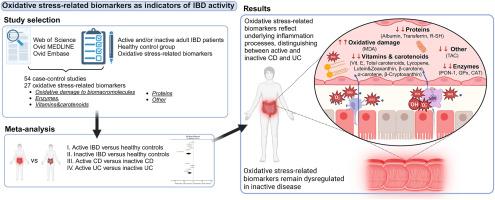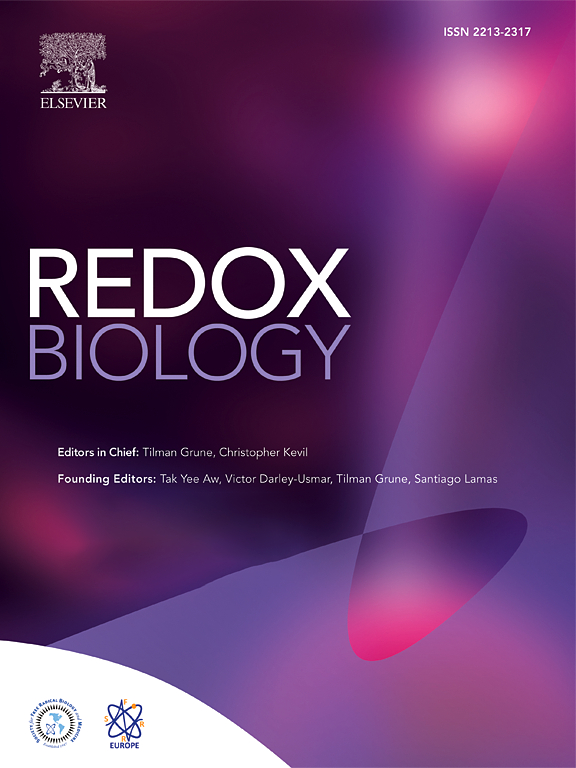氧化应激相关生物标志物作为炎症性肠病活动性的有效指标:系统综述与荟萃分析
IF 10.7
1区 生物学
Q1 BIOCHEMISTRY & MOLECULAR BIOLOGY
引用次数: 0
摘要
氧化应激被认为在炎症性肠病(IBD),尤其是克罗恩病(CD)和溃疡性结肠炎(UC)的发病机制中扮演着重要角色。这项荟萃分析旨在确定和量化 IBD 中与氧化应激相关的生物标志物及其与疾病活动的关系。我们系统检索了 Ovid MEDLINE、Ovid Embase 和 Web of Science 数据库,确定了 54 项纳入研究。比较研究包括(i) 活动性 IBD 与健康对照组;(ii) 非活动性 IBD 与健康对照组;(iii) 活动性 CD 与非活动性 CD;(iv) 活动性 UC 与非活动性 UC。我们的分析表明,与健康对照组相比,活动性和非活动性 IBD 患者体内生物大分子氧化损伤的生物标志物明显增多,同时各种抗氧化剂也有所减少。此外,我们还发现了区分活动性和非活动性 IBD 的生物标志物,包括丙二醛、副氧自由基酶 1、过氧化氢酶、白蛋白、转铁蛋白和总抗氧化能力。同样,副氧杂蒽酮酶 1、红细胞谷胱甘肽过氧化物酶、过氧化氢酶、白蛋白、转铁蛋白和游离硫醇的水平在活动性和非活动性 UC 之间也存在差异。维生素和类胡萝卜素也是 CD 和 UC 潜在的疾病活动性生物标记物,但要获得有意义的结果,应监测它们的摄入量。这些发现强调了氧化应激参与了 IBD 的发病机制,并突出了氧化应激相关生物标志物作为一种微创和额外的 IBD 活动监测工具的潜力。本文章由计算机程序翻译,如有差异,请以英文原文为准。

Oxidative stress-related biomarkers as promising indicators of inflammatory bowel disease activity: A systematic review and meta-analysis
Oxidative stress is believed to play an important role in the pathogenesis of inflammatory bowel disease (IBD), specifically Crohn's disease (CD) and ulcerative colitis (UC). This meta-analysis aimed to identify and quantify the oxidative stress-related biomarkers in IBD and their associations with disease activity. We systematically searched Ovid MEDLINE, Ovid Embase, and Web of Science databases, identifying 54 studies for inclusion. Comparisons included: (i) active IBD versus healthy controls; (ii) inactive IBD versus healthy controls; (iii) active CD versus inactive CD; and (iv) active UC versus inactive UC. Our analysis revealed a significant accumulation of biomarkers of oxidative damage to biomacromolecules, coupled with reductions in various antioxidants, in both patients with active and inactive IBD compared to healthy controls. Additionally, we identified biomarkers that differentiate between active and inactive CD, including malondialdehyde, Paraoxonase 1, catalase, albumin, transferrin, and total antioxidant capacity. Similarly, levels of Paraoxonase 1, erythrocyte glutathione peroxidase, catalase, albumin, transferrin, and free thiols differed between active and inactive UC. Vitamins and carotenoids also emerged as potential disease activity biomarkers for CD and UC, but their intake should be monitored to obtain meaningful results. These findings emphasize the involvement of oxidative stress in the pathogenesis of IBD and highlight the potential of oxidative stress-related biomarkers as a minimally invasive and additional tool for monitoring the activity of IBD.
求助全文
通过发布文献求助,成功后即可免费获取论文全文。
去求助
来源期刊

Redox Biology
BIOCHEMISTRY & MOLECULAR BIOLOGY-
CiteScore
19.90
自引率
3.50%
发文量
318
审稿时长
25 days
期刊介绍:
Redox Biology is the official journal of the Society for Redox Biology and Medicine and the Society for Free Radical Research-Europe. It is also affiliated with the International Society for Free Radical Research (SFRRI). This journal serves as a platform for publishing pioneering research, innovative methods, and comprehensive review articles in the field of redox biology, encompassing both health and disease.
Redox Biology welcomes various forms of contributions, including research articles (short or full communications), methods, mini-reviews, and commentaries. Through its diverse range of published content, Redox Biology aims to foster advancements and insights in the understanding of redox biology and its implications.
 求助内容:
求助内容: 应助结果提醒方式:
应助结果提醒方式:


